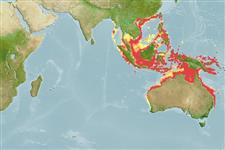Environment: milieu / climate zone / depth range / distribution range
Ekologi
marina; sötvatten; brackvatten bottenlevande; djupintervall 0 - 100 m (Ref. 6871). Tropical; 28°N - 32°S, 76°E - 165°E (Ref. 114953)
Indo-West Pacific: Thailand to New Guinea and the Solomon Islands, south to Australia. Records from the south coast of India, Sri Lanka, Bangladesh, and Myanmar need confirmation.
Length at first maturity / Size / Vikt / Age
Maturity: Lm 165.0, range 150 - 180 cm
Max length : 270 cm TL hane/ej könsbestämd; (Ref. 9909)
Occurs inshore and offshore, from the intertidal to offshore continental and insular shelves (Ref. 9909). Adults are found offshore waters while young individuals are found inshore on sand flats, around atolls, and in mangrove swamps (Ref. 6871). Feeds on shellfish, mainly on prawns and crabs (Ref. 9909, Ref. 114953). Ovoviviparous (Ref. 50449). Maturity size at 150-180 cm TL; born at 38-40 cm TL (Ref. 114953). Reported to live and breed permanently in fresh water (Ref. 6871). Probably the major commercial guitarfish in the Western Central Pacific (Ref. 9909). Caught regularly by demersal tangle net fisheries operating throughout the area. Utilized for its meat, fins (both very high value), skin and cartilage (Ref.58048). Reported to attain a maximum length of 4 m (Ref. 58784).
Exhibit ovoviparity (aplacental viviparity), with embryos feeding initially on yolk, then receiving additional nourishment from the mother by indirect absorption of uterine fluid enriched with mucus, fat or protein through specialised structures (Ref. 50449). Born at 38-40 cm TL (Ref.58048).
Last, P.R. and J.D. Stevens, 1994. Sharks and rays of Australia. CSIRO, Australia. 513 p. (Ref. 6871)
IUCN Red List Status (Ref. 130435)
Human uses
Warning: mysqli::__construct(): (08004/1040): Too many connections in /var/www/html/includes/func_getlabel.php on line 46
Can't connect to MySQL database (fbapp). Errorcode: Too many connections
